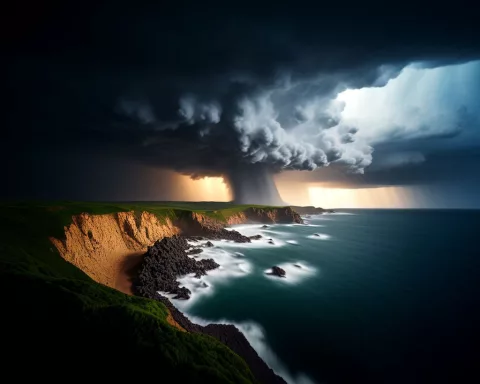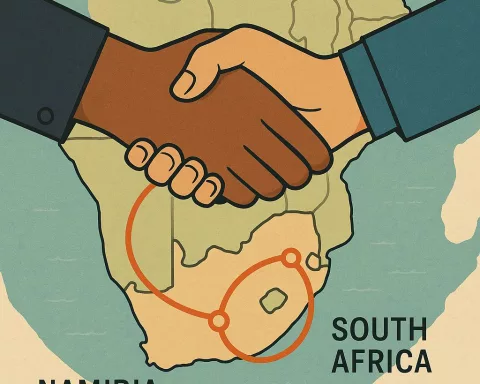A deluge of rain hit the Western Cape region, causing flooding and powerful winds. The South African Weather Service issued a severe warning for Cape Town and surrounding areas. The impact of the rainfall on communities was significant, with over 1,000 homes affected by the flooding. Despite the devastation, the community showed resilience and unity, offering assistance and support to each other in the face of adversity.
A Deluge of Rainfall in the Western Cape
The Western Cape region experienced a barrage of rain, causing extensive flooding, fierce thunderstorms, and powerful winds. The South African Weather Service (SAWS) issued a level nine warning for Cape Town and surrounding areas, emphasizing the potential for additional chaos and devastation. This article will delve into the immense scale of this extraordinary rainfall occurrence and the impact it had on the affected communities.
Over the weekend, the charming town of Franschhoek, situated in the heart of the Cape Winelands, saw an astonishing 299mm of rain. SAWS spokesperson Robin-Lee Batties verified this as the highest recorded amount in the area. Other regions also faced torrential rainfall, with Villiersdorp receiving 141mm, Jonkershoek 139mm, and the Moravian mission of Elim near Bredasdorp 129mm, all in just one day. The heavy downpour persisted until Monday, with Jonkershoek receiving an extra 61mm and other areas documenting significant totals as well.
Widespread Damage and Community Impact
The unyielding precipitation caused immense damage and flooding throughout the Western Cape. Preliminary estimates indicate that over 1,000 homes bore the brunt of the torrential rain, with countless lives disrupted and, in some instances, displaced. Among those affected were Boer Soek ‘n Vrou presenter Marciel Hopkins and her husband Handrè Lourens, who were staying at the MontMartre estate in Franschhoek when an enormous mudslide ripped through their chalet and the estate’s wedding venue.
Hopkins described the terrifying moments as they hurriedly tried to escape over the balcony with their bags when water and mud engulfed their dwelling. With the front doors blockaded by mud, their only choice was to face the elements in their PT shorts and climb to safety. The young couple posted pictures of the destruction on social media, expressing their sorrow for the impacted property owners.
The unceasing rain left the entire town of Franschhoek cut off, with every access road submerged by the floods. Both residents and visitors found themselves stranded, seeking refuge in local venues like the cooperation, where they drank coffee barefoot and prayed for the rain to relent. The community’s determination was evident as they united in the face of adversity, offering assistance to those in desperate need.
Road to Recovery and Resilience
With the rain finally subsiding, the clean-up operation commenced in full force. Motorists experienced significant delays and detours, as numerous major routes were closed due to flooding. The journey to recovery will undoubtedly be lengthy and challenging, as the Western Cape grapples with the incredible destruction wrought by these unparalleled rains.
Throughout history, nature has showcased its ability to create both beauty and devastation. The recent deluge in the Western Cape serves as a stark reminder of the power of the elements and the vulnerability of our man-made structures. However, it also highlights the unbreakable spirit and resilience of the people inhabiting this region.
In response to this natural disaster, communities have united to support each other, providing help, shelter, and a listening ear for those in need. As the waters recede and the landscape starts to recover, the strength and determination of the Western Cape’s residents will ensure their emergence as a stronger and more unified community than ever before.
The exceptional rainfall that has inundated the Western Cape has undoubtedly left an indelible mark on the region. Yet, as the skies clear and life begins to regain a sense of normality, it is the stories of bravery, solidarity, and unwavering resilience that will persist. For it is in the face of nature’s fury that we are reminded of the power of our collective humanity to overcome even the most daunting challenges.
- What was the impact of the rainfall on communities in the Western Cape?
The rainfall caused extensive flooding and over 1,000 homes were affected.
- What was the highest recorded amount of rain in the Western Cape during this event?
The town of Franschhoek received 299mm of rain, which is the highest recorded amount in the area.
3. How did the community respond to the flooding and devastation caused by the rainfall?
The community showed resilience and unity, offering assistance and support to each other in the face of adversity.
4. What was the extent of the damage caused by the rainfall in the Western Cape?
Preliminary estimates indicate that over 1,000 homes were damaged or destroyed, and countless lives were disrupted or displaced.
5. What is the outlook for recovery and rebuilding in the Western Cape after this natural disaster?
The recovery and rebuilding process will undoubtedly be lengthy and challenging, but the strength and determination of the community will ensure their emergence as a stronger and more unified community than ever before.












